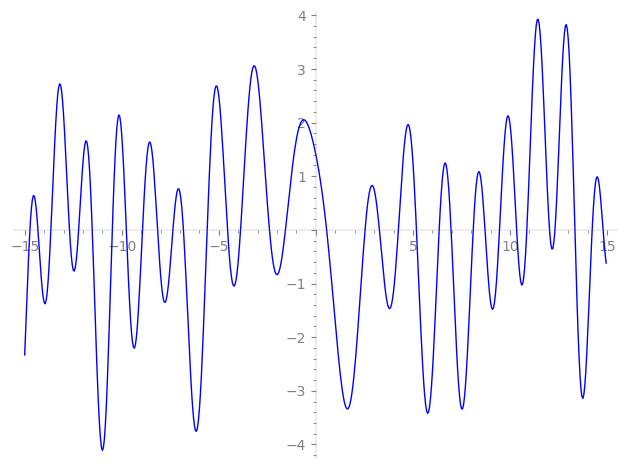| L(s) = 1 | + (0.742 − 0.742i)3-s + (−0.707 − 0.707i)5-s − 0.463i·7-s + 1.89i·9-s + (2.04 + 2.04i)11-s + (−3.94 + 3.94i)13-s − 1.04·15-s + 1.34·17-s + (−4.94 + 4.94i)19-s + (−0.344 − 0.344i)21-s + 3.84i·23-s + 1.00i·25-s + (3.63 + 3.63i)27-s + (1.09 − 1.09i)29-s + 3.17·31-s + ⋯ |
| L(s) = 1 | + (0.428 − 0.428i)3-s + (−0.316 − 0.316i)5-s − 0.175i·7-s + 0.632i·9-s + (0.617 + 0.617i)11-s + (−1.09 + 1.09i)13-s − 0.270·15-s + 0.326·17-s + (−1.13 + 1.13i)19-s + (−0.0751 − 0.0751i)21-s + 0.802i·23-s + 0.200i·25-s + (0.699 + 0.699i)27-s + (0.204 − 0.204i)29-s + 0.569·31-s + ⋯ |
\[\begin{aligned}\Lambda(s)=\mathstrut & 1280 ^{s/2} \, \Gamma_{\C}(s) \, L(s)\cr =\mathstrut & (0.382 - 0.923i)\, \overline{\Lambda}(2-s) \end{aligned}\]
\[\begin{aligned}\Lambda(s)=\mathstrut & 1280 ^{s/2} \, \Gamma_{\C}(s+1/2) \, L(s)\cr =\mathstrut & (0.382 - 0.923i)\, \overline{\Lambda}(1-s) \end{aligned}\]
Particular Values
| \(L(1)\) |
\(\approx\) |
\(1.397220579\) |
| \(L(\frac12)\) |
\(\approx\) |
\(1.397220579\) |
| \(L(\frac{3}{2})\) |
|
not available |
| \(L(1)\) |
|
not available |
\(L(s) = \displaystyle \prod_{p} F_p(p^{-s})^{-1} \)
| $p$ | $F_p(T)$ |
|---|
| bad | 2 | \( 1 \) |
| 5 | \( 1 + (0.707 + 0.707i)T \) |
| good | 3 | \( 1 + (-0.742 + 0.742i)T - 3iT^{2} \) |
| 7 | \( 1 + 0.463iT - 7T^{2} \) |
| 11 | \( 1 + (-2.04 - 2.04i)T + 11iT^{2} \) |
| 13 | \( 1 + (3.94 - 3.94i)T - 13iT^{2} \) |
| 17 | \( 1 - 1.34T + 17T^{2} \) |
| 19 | \( 1 + (4.94 - 4.94i)T - 19iT^{2} \) |
| 23 | \( 1 - 3.84iT - 23T^{2} \) |
| 29 | \( 1 + (-1.09 + 1.09i)T - 29iT^{2} \) |
| 31 | \( 1 - 3.17T + 31T^{2} \) |
| 37 | \( 1 + (6.89 + 6.89i)T + 37iT^{2} \) |
| 41 | \( 1 - 2.89iT - 41T^{2} \) |
| 43 | \( 1 + (-1.62 - 1.62i)T + 43iT^{2} \) |
| 47 | \( 1 - 3.29T + 47T^{2} \) |
| 53 | \( 1 + (3.29 + 3.29i)T + 53iT^{2} \) |
| 59 | \( 1 + (-6.84 - 6.84i)T + 59iT^{2} \) |
| 61 | \( 1 + (3.44 - 3.44i)T - 61iT^{2} \) |
| 67 | \( 1 + (-5.93 + 5.93i)T - 67iT^{2} \) |
| 71 | \( 1 - 15.8iT - 71T^{2} \) |
| 73 | \( 1 + 0.556iT - 73T^{2} \) |
| 79 | \( 1 - 4.23T + 79T^{2} \) |
| 83 | \( 1 + (7.06 - 7.06i)T - 83iT^{2} \) |
| 89 | \( 1 + 17.3iT - 89T^{2} \) |
| 97 | \( 1 - 9.04T + 97T^{2} \) |
| show more | |
| show less | |
\(L(s) = \displaystyle\prod_p \ \prod_{j=1}^{2} (1 - \alpha_{j,p}\, p^{-s})^{-1}\)
Imaginary part of the first few zeros on the critical line
−9.764526168127966677095083066387, −8.931931522910955261138292074791, −8.155003223269798184078622958727, −7.36475924874019476947651070621, −6.82374867882908507381192421504, −5.60139377071349817875815036701, −4.55311484035162591990478376708, −3.88025929360568469851734995195, −2.39228362261923318173354294223, −1.56861992944997859589942684074,
0.55214222235068564109990740425, 2.53234246113444725394344232281, 3.27026798953222219511042279008, 4.24784322057337752978309684035, 5.17964937679930300808828967391, 6.34925803128303053621075749635, 6.96274958336671817016186476004, 8.102818643387612122772375596470, 8.710881348286487808090260332932, 9.456220917786851651064458782130

